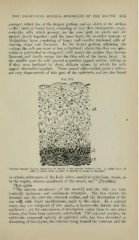Page 605 - My FlipBook
P. 605
—
:
THE EMBRYONAL MUCOUS MEMBRANE OF THE MOUTH. 615
younger, which lies at the deepest portion, and an older, at the surface
—the ' outer or horny layer, consisting of very thin, transparent, tough,
scale-like cells, which present, for the most part, no nuclei and are
packed closely together ; and the inner layer, the so-called mucous or
Malpighian layer, consisting of larger and smaller nucleated cells of
varying shape and character. In the deeper portion, adjoining the
corium, the cells are more or less cylindrical ; above this they are sphe-
still nearer the surface they become
roidal or polyhedral or elongated ;
flattened, and finally merge into the thin cells of the horny layer. In
the middle zone the cells present a peculiar jagged outline, looking as
if they were bordered by short, delicate spines, by which the cells
appear dovetailed together. These spined cells—called prickle cells
are very characteristic of this part of the epidermis, and are also found
Fig. 343.
Vertical Section Mucous Membrane of Mouth \' cm. porcine embryo X 2.10) : o/, older layer of
cells; //, infant layer of cells; ct, connective tissue of mesoblast.
in certain other parts of the body where stratified epithelium occurs, as
in the vagina, raucous membrane of the mouth, etc' " (Pruddcn).
Then again
'' The mucous membrane [of the mouth] and the skin are ana-
tomically analogous and continuous structures. The first clothes the
internal and the other the external surface, and the description of the
one will, wdth slight modifications, apply to the other. In a general
sense, they are composed of two strata, or layers—the dermis and the
epidermis yet, for convenience of description rather than for any other
;
reason, thev have been variously subdivided. The external stratum, the
epidermis, composed entirely of epithelial cells, has been described as
consisting of two layers, the external being termed the corneous and the
:
THE EMBRYONAL MUCOUS MEMBRANE OF THE MOUTH. 615
younger, which lies at the deepest portion, and an older, at the surface
—the ' outer or horny layer, consisting of very thin, transparent, tough,
scale-like cells, which present, for the most part, no nuclei and are
packed closely together ; and the inner layer, the so-called mucous or
Malpighian layer, consisting of larger and smaller nucleated cells of
varying shape and character. In the deeper portion, adjoining the
corium, the cells are more or less cylindrical ; above this they are sphe-
still nearer the surface they become
roidal or polyhedral or elongated ;
flattened, and finally merge into the thin cells of the horny layer. In
the middle zone the cells present a peculiar jagged outline, looking as
if they were bordered by short, delicate spines, by which the cells
appear dovetailed together. These spined cells—called prickle cells
are very characteristic of this part of the epidermis, and are also found
Fig. 343.
Vertical Section Mucous Membrane of Mouth \' cm. porcine embryo X 2.10) : o/, older layer of
cells; //, infant layer of cells; ct, connective tissue of mesoblast.
in certain other parts of the body where stratified epithelium occurs, as
in the vagina, raucous membrane of the mouth, etc' " (Pruddcn).
Then again
'' The mucous membrane [of the mouth] and the skin are ana-
tomically analogous and continuous structures. The first clothes the
internal and the other the external surface, and the description of the
one will, wdth slight modifications, apply to the other. In a general
sense, they are composed of two strata, or layers—the dermis and the
epidermis yet, for convenience of description rather than for any other
;
reason, thev have been variously subdivided. The external stratum, the
epidermis, composed entirely of epithelial cells, has been described as
consisting of two layers, the external being termed the corneous and the


